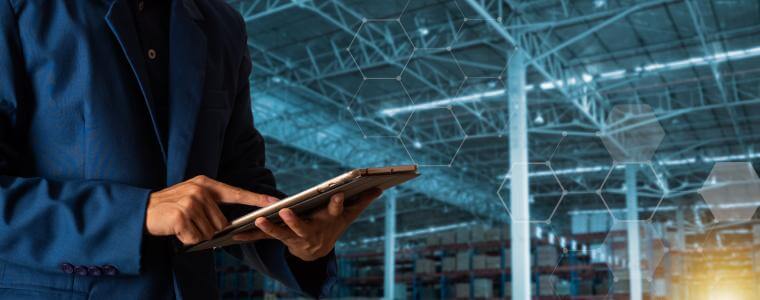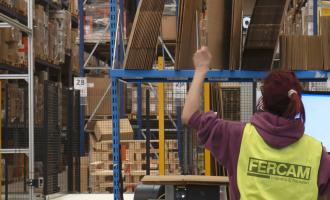
25 September 2020 - by: Eleonora Castagna
Seize the opportunity in the crisis to rethink your supply chain
Not only reacting to today's problems but investing correctly in the future, this is the most current challenge for those in charge of logistics chains. How to structure a resilient supply chain? The key concepts are continuous monitoring and flexibility of adopted solutions.

Andrew Stephen Grove, Intel CEO, said: "Bad companies are destroyed by crisis, good companies survive them, great companies are improved by them". The Covid-19 pandemic that still rages throughout most of the world has undoubtedly brought with it conspicuous changes and has significantly impacted most markets. The immediate and generalized translation? Uncertainty and a high need for flexibility and resilience.
Many companies will tend to freeze their projects, postpone investments and limit expenses, but is this really the right answer? In all probability we are experiencing a moment of profound change and innovation, not a momentary slowdown. Therefore, it seems legitimate to ask whether waiting for things to return to their previous state is the right strategic move. Perhaps, only Companies that are able today to imagine a different future and are the first to take steps in the right direction will emerge. If it is time to react to this rift in the systems to which we referred earlier, the answer that provides only precautionary measures against contingent events does not maximize the lessons that can derive from it. Let’s instead open up to the opportunity to rethink supply chains to make them more solid and resistant.
The objective of careful examination must be the latter in particular, with the aim of assessing their financial and structural soundness. It will thus be possible to understand strengths and weaknesses, assess the implications of any breaks in the chain and develop business continuity plans, with solutions that can make up for them. Risk reduction and being prepared to face sudden changes will be the cornerstones for a good development of activities in the coming months, naturally with due attention to any increase in costs to obtain guarantees of greater safety. Another parameter of crucial importance is the location of the nodes of the supply chain.
With respect to the product, the suggestion would be not to necessarily foresee a volumetric increase in warehouse stocks, but to organize a redistribution of existing goods in key points, to capillarize presence throughout the logistics network, at the same time avoiding the commitment of further capital in this moment of economic uncertainty. Never before has investment in smart inventory management systems made this big of a difference between an optimized and efficient flow and a flow in which lack of information and the inability to predict the impacts of changes will almost surely cause losses and slowdowns.
Long-range visibility over the entire supply chain means the ability to receive information in real time, not only from first-level suppliers, but also from second and third-party suppliers. But it also means that management’s vision should not stop at the horizon of the next few weeks, but consistently push towards medium and long-term goals, possibly thanks to the support of a consistent and constantly updated database.
How to assess if your company is flexible enough? Some crucial questions and KPIs relating to structures, internal organization and adopted systems, constantly monitored, will be important tools for an objective control of the level of agility of your Company. Questions about order management, inbound logistics and warehouse stock, rotation of goods, production rates compared with demand and effective distribution capacity will have to be asked recurrently. But above all it will be necessary to design one's own adaptability to the dynamics of different markets compared to the past, making variability a constitutive element of one's own structure, rather than an external disturbing agent.
Many companies will tend to freeze their projects, postpone investments and limit expenses, but is this really the right answer? In all probability we are experiencing a moment of profound change and innovation, not a momentary slowdown. Therefore, it seems legitimate to ask whether waiting for things to return to their previous state is the right strategic move. Perhaps, only Companies that are able today to imagine a different future and are the first to take steps in the right direction will emerge. If it is time to react to this rift in the systems to which we referred earlier, the answer that provides only precautionary measures against contingent events does not maximize the lessons that can derive from it. Let’s instead open up to the opportunity to rethink supply chains to make them more solid and resistant.
Products and suppliers: key points to address for designing resilient supply chains
The challenge for supply chains of the near future will be the fluctuation in volumes with difficult peaks to forecast, negative or positive. Efforts should focus on analyzing new consumption habits, to set up-to-date parameters and find the right focus for investments. With the evolution of the market, it is possible that you may find yourself having to evaluate shorter supply chains or different routes, new products or different suppliers.The objective of careful examination must be the latter in particular, with the aim of assessing their financial and structural soundness. It will thus be possible to understand strengths and weaknesses, assess the implications of any breaks in the chain and develop business continuity plans, with solutions that can make up for them. Risk reduction and being prepared to face sudden changes will be the cornerstones for a good development of activities in the coming months, naturally with due attention to any increase in costs to obtain guarantees of greater safety. Another parameter of crucial importance is the location of the nodes of the supply chain.
With respect to the product, the suggestion would be not to necessarily foresee a volumetric increase in warehouse stocks, but to organize a redistribution of existing goods in key points, to capillarize presence throughout the logistics network, at the same time avoiding the commitment of further capital in this moment of economic uncertainty. Never before has investment in smart inventory management systems made this big of a difference between an optimized and efficient flow and a flow in which lack of information and the inability to predict the impacts of changes will almost surely cause losses and slowdowns.
Watchwords: agility and visibility
Certainly these are issues already included in the development strategies of many Companies, but the new needs that emerged during and after the pandemic peak have given an important boost to digitization projects and highlighted the need for more agile processes. For many companies, this may have to translate into the acquisition of new analysis, monitoring and management software or the implementation of more advanced business intelligence techniques than previously activated.Long-range visibility over the entire supply chain means the ability to receive information in real time, not only from first-level suppliers, but also from second and third-party suppliers. But it also means that management’s vision should not stop at the horizon of the next few weeks, but consistently push towards medium and long-term goals, possibly thanks to the support of a consistent and constantly updated database.
How to assess if your company is flexible enough? Some crucial questions and KPIs relating to structures, internal organization and adopted systems, constantly monitored, will be important tools for an objective control of the level of agility of your Company. Questions about order management, inbound logistics and warehouse stock, rotation of goods, production rates compared with demand and effective distribution capacity will have to be asked recurrently. But above all it will be necessary to design one's own adaptability to the dynamics of different markets compared to the past, making variability a constitutive element of one's own structure, rather than an external disturbing agent.
Share


 Language
Language

























